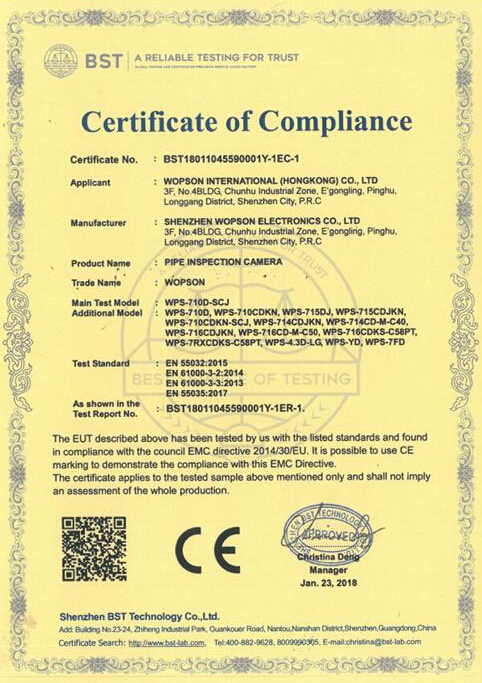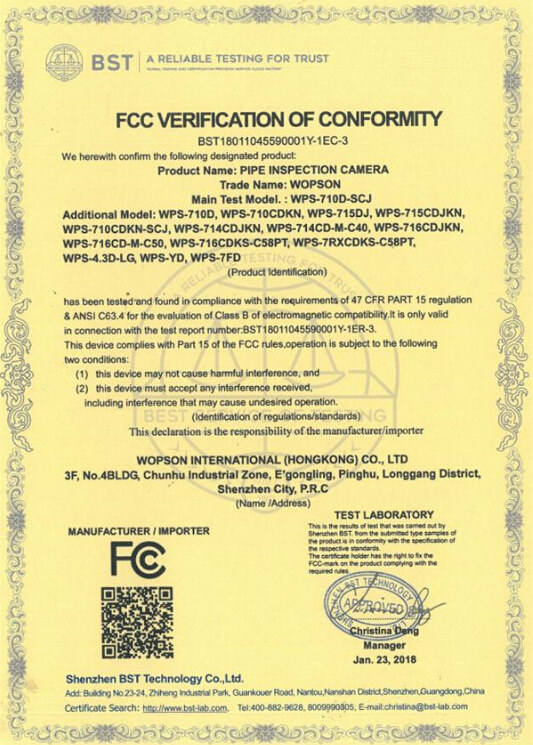Contact Details
-
- Email : mary@wopson.com
- Phone : 008616670203501
- Fax : 008675584692156
- Address : 3F,No.4BLDG, Chunhu Industrial Zone , E'gongling,Pinghu, Longgang District,Shenzhen City, P.R.C
News
-
Basic regulations on the detection and assessment of urban drainage pipes
2019-01-09
1. Units engaged in the detection and assessment of urban drainage pipelines shall have corresponding qualifications, and the inspection personnel shall have corresponding qualifications.
2. The instruments and equipment used for the inspection of urban drainage pipelines shall have a certificate of product certification and a valid verification (calibration) certificate of the certification body. Newly purchased equipment that has been re-enabled after overhaul or long-term decommissioning should be calibrated and calibrated prior to being tested.
3. The pipeline inspection method should be selected according to the specific conditions of the site and the adaptability of the testing equipment. When a test method does not fully reflect the condition of the pipeline, multiple methods can be used for joint detection.
4. The census period for the purpose of structural conditions should be 5a to 10a, and the census period for the purpose of functional conditions should be 1a to 2a. The census cycle can be shortened when one of the following conditions is encountered:
1. Pipes in special areas such as sand-prone and wet soil;
2. Pipes with a pipe age of 30 years or more;
3. Pipes with poor construction quality;
4. Important pipelines;
5. There are special requirements for the pipeline.
5. Pipeline testing and evaluation should be carried out according to the following basic procedures:
Accept the commission;
2. Site survey;
3. Preparation before testing;
4. On-site inspection;
5. Internal industry data compilation, defect interpretation, pipeline assessment;
6. Write a test report.
6. The testing unit shall collect relevant data in the pipeline area to be tested according to the requirements, organize technical personnel to conduct on-site reconnaissance, master the site conditions, formulate testing plans, and prepare for testing.
7. The following information should be collected before pipeline inspection:
1. Technical data such as existing drainage pipeline maps;
2. Historical data of pipeline inspection;
3. Relevant pipeline data in the pipeline area to be tested;
4. Engineering geological and hydrogeological data in the pipeline area to be tested;
5. Other relevant information needed for the assessment.
8. Site surveys should include the following:
1. Observe the surrounding environmental conditions such as features, landforms and traffic conditions in the pipeline area to be tested;
2. Check the water level at the pipe mouth, deposit and check the structure of the well;
3. Check the inspection well location, pipeline depth, pipe diameter, pipe and other information.
9. The testing plan should include the following:
1. The mission, purpose, scope and duration of the inspection;
2. Overview of the pipeline to be tested (including on-site traffic conditions and analysis of historical data);
3. Selection of testing methods and control of the implementation process;
4. Quality assurance, health, safety, transportation organization, environmental protection and other guarantee systems and specific measures;
5. Possible problems and countermeasures;
6. Workload estimation and work schedule;
7. Personnel organization, equipment, material planning;
8. Information on the results to be submitted.
10. The on-site testing procedures should meet the following requirements:
1. Pre-treatment of the pipeline according to the requirements of the test method before testing;
2. The equipment should be inspected;
3. Pipeline testing and preliminary interpretation should be carried out;
4. The site and maintenance equipment should be cleaned up in time after the test is completed.

